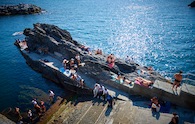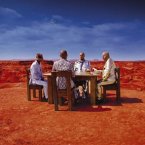Welcome to one of the most active flamenco sites on the Internet. Guests can read most posts but if you want to participate click here to register.
This site is dedicated to the memory of Paco de Lucía, Ron Mitchell, Guy Williams, Linda Elvira, Philip John Lee, Craig Eros, Ben Woods, David Serva and Tom Blackshear who went ahead of us.
We receive 12,200 visitors a month from 200 countries and 1.7 million page impressions a year. To advertise on this site please contact us.
|

|
|
Compas Structures
|
You are logged in as Guest
|
|
Users viewing this topic: none
|
|
Login  | |
|

   
Ron.M
Posts: 7051
Joined: Jul. 7 2003
From: Scotland

|
 RE: Compas Structures (in reply to Skai) RE: Compas Structures (in reply to Skai)
|
|
|
quote:
I'm having real problems understanding compas..
Everybody has, Skai.
You must study first the underlying theory of what is taught as the 12 beat cycles of Soleares, Alegrias, Bulerias, Siguiriyas etc.
These are the most "foreign" ones to our ears.
So long as you can count to 12 then you should be able to get a grasp of this quite quickly.
Thereafter there is the understanding and knowing how to work with the various cycles that is very much more difficult.
It's very different, for instance, than getting the grasp of say, Reggae rhythm, which is a bit weird at first, but once you catch it, it's like riding a bike.
Over the past thirty years or so, folk have explored the various underlying sub rhythms of these already complex rhythms in order to refresh the sound.
A lot of this has been taken up and is now a de facto part of everyday Flamenco.
Flamencos have a lot of fun playing around with the rhythm and still being dead on compás.
I honestly don't think there is any fast track to this other than listening to Flamenco music a lot and preferably playing with Singers and Dancers if you can.
It's definitely a journey!
And a very enjoyable, if sometimes frustrating one!
I would highly recommend the "Understanding Flamenco" CD available on various sites including Flamenco-World.com
cheers
Ron
|
|
|
|
REPORT THIS POST AS INAPPROPRIATE |
Date Sep. 30 2004 20:19:34
 |
|

   
Jon Boyes
Posts: 1377
Joined: Jul. 10 2003

|
 RE: Compas Structures (in reply to Skai) RE: Compas Structures (in reply to Skai)
|
|
|
quote:
ORIGINAL: Skai
I'm having real problems understanding compas..
For example, if bulerias, peteneras and guajiras have the same structure, why don't they sound similar apart from being different keys?
Well you've given one reason - key/mode (although Buleria can be played in Aminor). You also have tempo thats different, and -crucially - the aire of these palos. That kind of means the mood and emotions conveyed but these things don't translate too well. Think of it this way, if you were playing a Guajiras you want to be thinking about lazing on a beach in Cuba under a palm tree watching the girls go by. Bulerias on the other hand is full of nervous tension and energy just waiting to burst - totally different. The cante lyrics reflect this kind of stuff.
The only things that they have in common are a 12 beat cycle, and one possible pattern of accents within that cycle. However, when you start getting further into all this you find that even this doesn't hold true - there are many ways of accenting a bulerias, for example.
So that's why they sound different 
For the second part of your question, see above - lots of good advice there ie take one palo at a time, get a flamenco metronome to jam along with, get a teacher if you can find a good one.
Juan Martin and Graf Martinez both publish great methods. Learning solo pieces is helpful, but only if you take the time to look beyond the falsetas ie there is a danger of 'not seeing the wood for the trees'.
Yes, learning some palmas can be helpful too. If I was teaching a beginner in the first lesson I'd have them clapping out the compas to Soleares before they pick up their guitar.
Leave bulerias for a while - its the hardest palo to learn. That's one thing you will usually find everyone agrees on 
Jon
|
|
|
|
REPORT THIS POST AS INAPPROPRIATE |
Date Oct. 1 2004 8:44:25
 |
|

   
Jon Boyes
Posts: 1377
Joined: Jul. 10 2003

|
 RE: Compas Structures (in reply to Skai) RE: Compas Structures (in reply to Skai)
|
|
|
quote:
ORIGINAL: Skai
BTW just what makes the bulerias the hardest to get?
Thats what the rest of us would like to know 
Tempo, definitely for one thing. Its one thing having to cope with this bizarre 12 beat cycle at slow speeds (eg solea) but at bulerias speed, things are much harder to keep together.
Different patterns if accents, different styles of bulerias, contratiempo and god knows what else all combine together to make life difficult too. Listen to a Paco de Lucia Buleria and you have guitar technique developed to an insane level 
Strangely, several methods and tutors teach bulerias by deriving it from solea, speeding things up, then talking about starting the accents on a different beat. I have to say that that I think this makes matters even worse and more confusing for someone learning it.
IMO its better to treat bulerias as something different and not confuse the issue with other palos (the stuff about buleria coming historically from solea is contentious anyway).
Learn the chords, learn the changes, learn what beats in the cycle are the important ones to 'aim' for, buy Ron's metronome and let it doing the counting for you.
Jon
PS Mike suggested Sal's excellent site above - have a look for his section on dance accompaniment for free samples of his CD. Also, the Flamenco Teacher lesson section has free Alegrias ands bulerias basic compas you can download (ie no falsetas, just the compas).
|
|
|
|
REPORT THIS POST AS INAPPROPRIATE |
Date Oct. 2 2004 9:24:45
 |
|

   
Kate
Posts: 1827
Joined: Jul. 8 2003
From: Living in Granada, Andalucía

|
 RE: Compas Structures (in reply to Jon Boyes) RE: Compas Structures (in reply to Jon Boyes)
|
|
|
I was told a story by an old flamenco about bulerías, as we sat one night me trying to master it with everyone laughing at me. "They are pulling your leg ," he said, "that is the origin of the Bulería. Long ago when Gypsy music became fashionable and people came to learn, it was a game we played with payos. The minute the thought they had the rhythm, someone would change it subtly, accents would move, or they would clap the counterpoint and the payo would panic." As soon as I knew they were trying to catch me out and throw me off track I found it easier, well less panic and more like laugh like hell every time I lost it.
The night Remedios Amaya challenged me to sing Tom Jones por Bulería, there was discussion about the difference between how the Granada flamencos clap a bulería and how its done in Jerez. One of the Granada flamencos there demonstrated it and Remedios announced " están tomando el pelo" ( They're taking the piss).
So that's the reason we find it so difficult, they really are taking the piss. The 12 beat is outside of our musicial reference, precisely because its sole purpose is to frustrate the hell out of us foreigners and give all the flamencos a good laugh.
kate
_____________________________
Emilio Maya Temple
http://www.amazon.co.uk/gp/product/B000CA6OBC
http://www.cdbaby.com/cd/emiliomaya
|
|
|
|
REPORT THIS POST AS INAPPROPRIATE |
Date Oct. 2 2004 10:25:10
 |
|
 New Messages New Messages |
 No New Messages No New Messages |
 Hot Topic w/ New Messages Hot Topic w/ New Messages |
 Hot Topic w/o New Messages Hot Topic w/o New Messages |
 Locked w/ New Messages Locked w/ New Messages |
 Locked w/o New Messages Locked w/o New Messages |
|
 Post New Thread
Post New Thread
 Reply to Message
Reply to Message
 Post New Poll
Post New Poll
 Submit Vote
Submit Vote
 Delete My Own Post
Delete My Own Post
 Delete My Own Thread
Delete My Own Thread
 Rate Posts
Rate Posts
|
|
|
Forum Software powered by ASP Playground Advanced Edition 2.0.5
Copyright © 2000 - 2003 ASPPlayground.NET |
0.078125 secs.
|


 Printable Version
Printable Version












 New Messages
New Messages No New Messages
No New Messages Hot Topic w/ New Messages
Hot Topic w/ New Messages Hot Topic w/o New Messages
Hot Topic w/o New Messages Locked w/ New Messages
Locked w/ New Messages Locked w/o New Messages
Locked w/o New Messages Post New Thread
Post New Thread